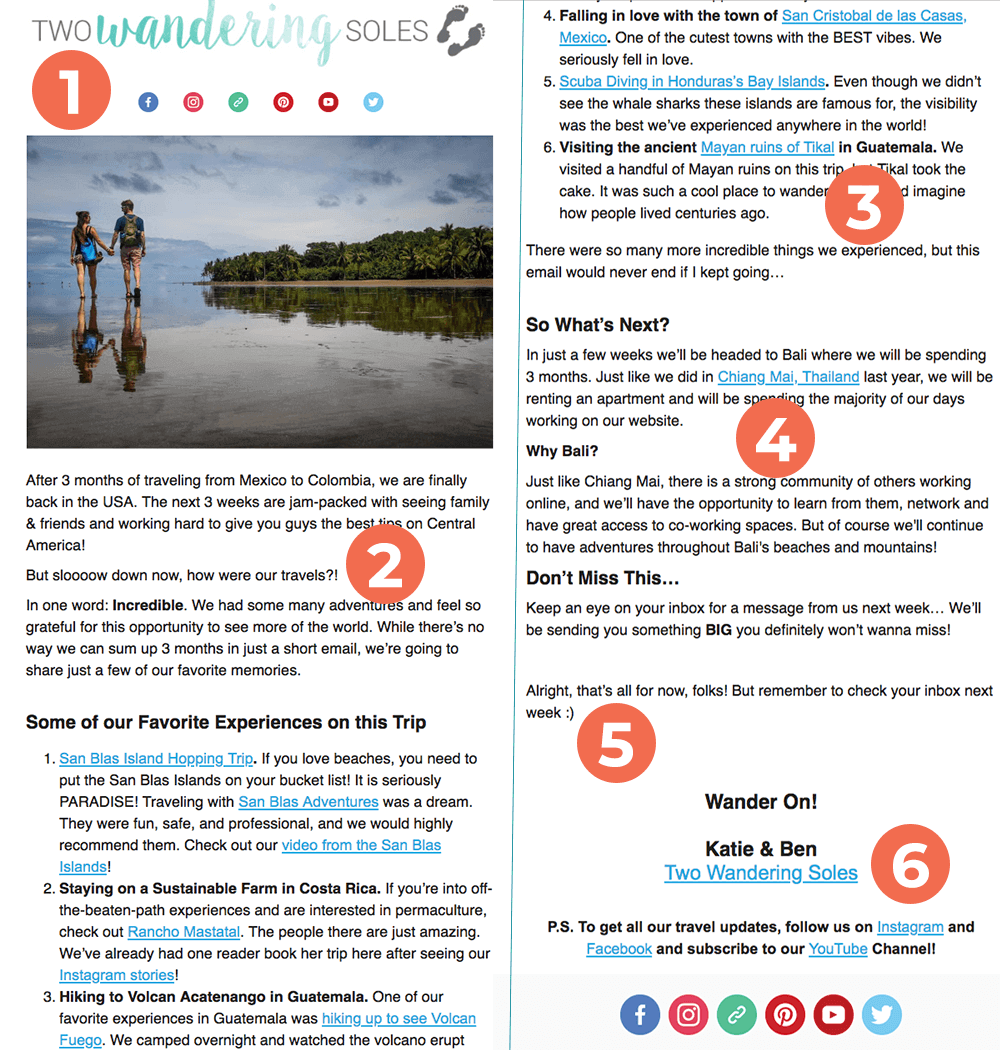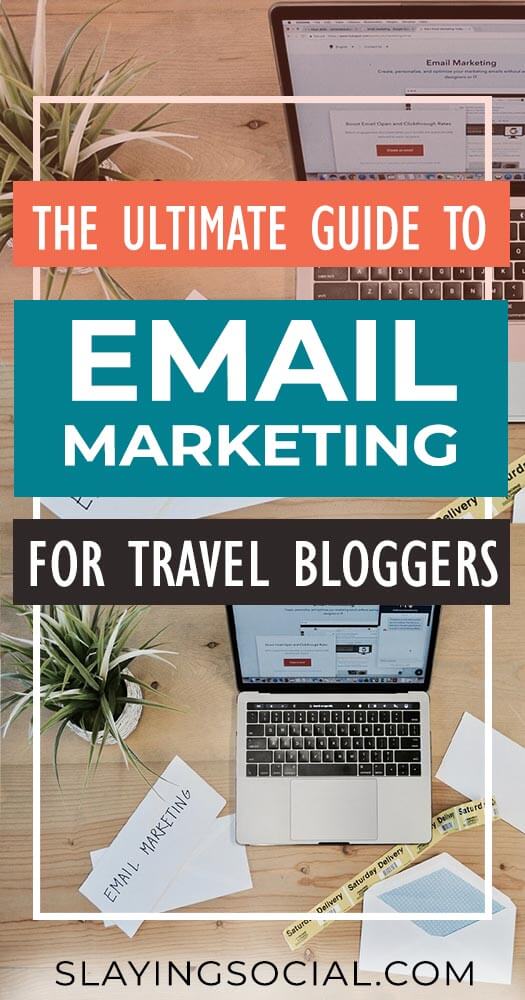*FYI - this post may contain affiliate links, which means we earn a commission at no extra cost to you if you purchase from them. Also, as an Amazon Associate I earn from qualifying purchases. Check out our Privacy Policy and Disclosure. for more info.
Imagine if social media were to cease to exist tomorrow. No more Instagram, Facebook, or Twitter … all gone. Is your lunch currently rising in a swell of absolute terror?!
BREATHE, it was just pretend… but it’s not THAT out of the realm of possibility. After all, the land of social media is forever changing without any warning whatsoever. You never know when an algorithm will suddenly render you obsolete, or a merger will evaporate your followers in an instant. G+ just announced it’s closing its doors, which … I mean, I know absolutely nobody who’s upset about it, but there’s probably like ONE super popular G+ star out there who’s currently freaking out.
There’s a reason why we spend so much time cultivating our social media profiles and following even though it’s ultimately totally out of our control and honestly kind of a gamble: social media is the best way to interact with and develop a relationship with our audience.
Or is it?
What if I told you you could interact and develop the relationship with your audience on your own terms? That’s the beauty of your email list: those subscribers are like followers that you OWN – they’re YOUR email list and you can do whatever you want with them (within FTC and GDPR guidelines, of course). Sure, they may unsubscribe, but if you can develop an email strategy that keeps them happy, not only will you be fostering your relationship with them, but you can drive traffic right back to your blog – AND earn money from your email list, too.
I know, it may sound a little weird to think of your email list as more valuable than your Instagram followers. But they are. They’re actually even more valuable than your casual blog readers. Your email subscribers are your most loyal, loving readers. They like you and your content SO MUCH, they gave you access to their inbox – that’s kind of a big deal. And that relationship of trust should be nurtured and built upon, not ignored.
So for those of you who haven’t started cultivating an email list yet, or those of you who have an email list but aren’t currently doing anything with it … guess what? By the end of this post, my goal is for this to be you, hard at work on your email marketing:
The Bottom Line: Focusing on email marketing can elevate your blog and give you security that social media and search engine algorithms don’t. It’s a reliable source of relationship-building for your audience, and it can even be used to drive revenue as well!
Psst: This is the final post in a series we wrote about taking your travel blog to the next level. Check out the other posts here:
- 7 Mistakes That Are Crushing Your Travel Blog’s Success in 2018 (And How to Fix Them)
- How to Make Money Travel Blogging: The Ultimate Guide
- Brand Collaborations & Travel Sponsorship 101: Nailing the Perfect Pitch
- Networking Basics for Travel Bloggers: How to Network Without Crying
The Best Email Marketing Services for Travel Blogs
Before you can start building that email list and propelling yourself to email marketing success, you’ll need to sign up for an email marketing service. These services do everything from hosting your list to sending out your emails to giving you “subscribe” boxes and forms to post on your site. So … yes, you need one!
Good news for your penny-pinchers who haven’t yet taken to heart all of our nagging about investing in yourself and your business: you don’t have to pay for an email marketing service at first if you don’t want to. There are tons of options for great email marketing clients, and many of them are free – at first. Most will begin charging after you hit a certain number of subscribers.
Once you build your list to the point where you’ll need to start paying to use it, it’s time to move on to the next level and really nail down your email marketing strategy. So keep that in mind: if you sign up for a freebie service now, you’ll very likely have to move your list over and start from scratch again somewhere else later.
Here are 4 email service providers we’ve personally had experience using and can recommend.

MailChimp
Everyone knows about MailChimp and I’m like 99% sure it’s because of their adorable commercial at the beginning of every episode of Serial. Damn, was that effective or what? The service is easy to get up and running on quickly, it’s free up to 2k subscribers, it integrates with most WordPress templates and plugins, and its branding is cute and little cheeky, which I always appreciate.
There are, however, some drawbacks: MailChimp’s strongest features are its beautiful, easy-to-create template. Which is great if you have products or photos you want to feature or if design is a big part of your brand. It can also be automated fairly easily: I used MailChimp to set up gorgeous monthly newsletters with all of my newest posts, pulled from my RSS feed and sent automatically, so I didn’t have to lift a finger.
That said, there are some limitations: MailChimp isn’t great at segmenting your subscribers. It’s also not great for automating much more than a very basic (albeit beautiful) newsletter. Complexity isn’t its strong suit – which isn’t necessarily a bad thing, if you’re just starting out with email marketing.
I started Practical Wanderlust’s email list on MailChimp and I was pretty happy with it … right up until I hit 2k subscribers, which is the limit for free accounts. Then I decided that their tools weren’t robust enough for me to justify paying for the long haul, and I switched.
Here’s the good news: switching over my email list was pretty easy. Export from Mailchimp, import elsewhere, done.
Here’s the bad news: I occasionally still get subscribers coming from old posts because of deep-links I embedded deep into my blog posts at some point and never bothered to remove because it’s a ton of work. Sigh.
The Bottom Line: If you’re just starting out with email marketing and aren’t ready to do much more than send the occasional newsletter, MailChimp is easy to start with and free for the first 2k subscribers. Sign up for MailChimp and give it a try!
MailMunch
MailMunch is another free, easy to use email marketing service. Their specialty is helping you grow your email list – they have some of the snazziest forms and opt-in tools out there. The rest of their services are pretty standard: you can send broadcasts and automate your “welcome” email whenever you get a new subscriber, but that’s about it. Analytics, A/B testing, and other features aren’t available with a free account.
You can use MailMunch as an alternative to MailChimp – or in conjunction with it. I signed up with MailMunch to access some types of opt-in forms that MailChimp didn’t offer, like forms that politely slid into view when a reader scrolled 50% of the way down a post, or forms that politely popped up when a reader dared to approach the “X” button to leave my blog.
MailMunch has many of the same limitations that MailChimp does: it’s great at forms and opt-ins, but not great at much else, and it limits you from doing anything much more complex than sending the occasional newsletter. Their free newsletter options are also incredibly limited, so I automatically funneled all of my MailMunch subscribers right into my MailChimp account to use THEIR newsletter templates instead. I liked that I could easily segment my subscribers into different lists based on which opt-in form they signed up for more easily in MailMunch than I could in MailChimp. But even with both services, I still felt like I couldn’t do as much with my email list as I wanted to…. so when I stopped using MailChimp, I stopped using MailMunch as well.
But even though I stopped actively using it, a few abandoned forms are still popping away on maybe 2-3 posts… and my abandoned MailMunch list has grown to nearly 1k. … Oops. I guess those things really work though, huh?
The Bottom Line: If your primary concern is growing your email list, MailMunch has a great selection of form options available for free accounts. Sign up for MailMunch and give it a try!

ConvertKit
So, let me start right away with this: I LOVE ConvertKit. It’s the platform we use both for Slaying Social’s email list AND for Practical Wanderlust. That said: it’s more advanced and complex than all of the other options in this list. If you’re going to dive into email marketing and REALLY make it work for you, ConvertKit is the best choice.
ConvertKit’s strength is NOT fancy email templates – in fact, they recommend only doing the bare minimum and avoiding the flashy, image-packed templates altogether. Instead, it’s strength lies in its complex automation abilities and the ability to “tag” subscribers.
My entire email marketing strategy is based off of the ability to “tag” subscribers. Essentially, every time a subscriber clicks on or even reads an article, you can “tag” them with some crucial piece of information that will help you effectively market to them. For example, the readers who are finding my blog through my posts about Disney World are VERY different than the readers who are finding my blog through my posts about backpacking through Colombia. I don’t want to send backpacking content to my Disney World readers and I don’t want to send my backpacking readers tips for visiting Disney World – unless they’re into both, of course.
ConvertKit helps me get to a level of low-key stalking, allowing me to essentially make assumptions about my readers based on what they click on and which posts they read. Creepy? Maybe a little. But like … in a very basic way. The information I have about my readers essentially amounts to the region they live in and random notes like “interested in Nashville, TN” or “outdoorsy.” So it’s not quite on the same level as like, Facebook knowing you’re pregnant before you do. *shudder*
With other email marketing systems, you might be able to create multiple opt-ins and forms which help you determine a small piece of what that reader is interested in or how they initially signed up for your email list – but when it comes to building a more robust set of information about their varied interests, things get much more complicated. ConvertKit makes it easy. Every time you put a link in a newsletter, you can set it to “tag” anyone who clicks on it with whatever you like.
That tagging ability is the difference between sending an email blast to your entire list and crossing your fingers, and sending a targeted newsletter to subscribers who actually WANT to know the information you’re sharing. In terms of numbers, it’s the difference between my 35% newsletter open rate and my 75% targeted email open rate. Yep. That’s a big difference.
Although ConvertKit is the most expensive service on our list, I find that the cost is worth it thanks to its powerful ability to both drive visitors to my site (earning me ad revenue) AND its ability to deliver monetized, value-packed emails directly to the subscribers who need it at just the right time. Imagine this: I’m able to determine exactly when a subscriber is planning a trip to a specific destination, and serve them up recommendations for where to stay, what to pack, tours to book, and other travel tips directly to their inbox, exactly when they need it – which both helps them plan their trip AND earns me affiliate income. That’s very powerful … and incredibly effective.
I don’t just earn ad revenue from my email list: I’m also earning affiliate income – AND building a trusting relationship with my readers that is the foundation of everything I do. To me, that makes ConvertKit well worth it.
That said: it’s not the easiest to set up, it’s fairly labor intensive (until you’ve got your automations set up), and there’s no “free until X subscribers” trial option. But if you’re willing to put in the work and invest in your email list, it’s an incredible tool.
The Bottom Line: If you’re committed to not just growing your email list but really using it to its full potential, including monetizing your list and effectively driving traffic back to your site, ConvertKit is well worth the money. Of all the tools on this list, it’s the most expensive BUT when used to its full potential, by FAR the most powerful. Sign up for ConvertKit and give it a try.
MailerLite
MailerLite is basically what would happen if MailChimp and ConvertKit got together to have a simple, but convenient little baby. If you want to get started with more sophisticated email marketing like automations, but are scared to drop the amount of dough required by ConvertKit, then MailerLite is a great middle ground.
Christina currently uses MailerLite to manage one of her other blogs (yes, that’s right – another blog) and is happy with the experience so far, especially since it’s free to use up to 1000 subscribers.
Firstly, price-wise, it is leaps and bounds more affordable than ConvertKit. Your first 1000 subscribers are free, so you get a chance to play with all the features before committing to a paid plan (which are still cheaper than ConvertKit’s).
Feature-wise, they offer everything you would need as a beginner in email marketing. Their drag and drop interface for emails is similar to MailChimp, and makes it easy to design nice-looking emails. Plus, they have a pretty big selection of sleek landing page templates and forms as well. What especially sets it a step above MailChimp though is its capability for automations and sequences, like ConvertKit.
Of course, MailerLite isn’t perfect. While it’s capable of more than MailChimp, it still lacks some of the more complex and sophisticated features of ConvertKit when it comes to automations. I tested it out as a cheaper alternative to ConvertKit, and found that much of what I’m doing is difficult to set up on MailerLite – ConvertKit makes doing very complex things fairly easy and straightforward, but MailerLite is a little bit more confusing and not quite as intuitive.
Christina also had a negative experience a few months back when they had a spam issue that led to her emails being sent to spam boxes for about a week. While this was kind of a “freak accident” type thing, it’s still a potential issue to be mindful of.
The Bottom Line: If you want to get started with more complex email marketing like sequences and automations, but don’t yet feel ready to make the financial commitment that is ConvertKit, MailerLite might be a good option for you. Sign up for MailerLite now!

How to Get Email Subscribers
This is a topic that’s covered a zillion times in other blogs, and is honestly what I consider to be one of the EASIER aspects of email marketing. So, good news: it’s not that difficult to get email subscribers. All you need is a little creativity. Er, and an email service.
Creating an Email List Form
You can’t build email subscribers if they don’t have a way to actually subscribe to your list! That’s probably pretty obvious, right? Enter the Email List Form. All of the email list providers we recommended have a way to create and insert a form on your site. We recommend using them to build your list rather than enabling a “subscribe” button on your comment box, which is easy to miss and offers you far less control over who gets sent what, when.
So no matter which service you sign up with, you’ll want to create a form. There are several ways to have that form appear to your readers.
- Manually embed the form in individual blog posts. On Practical Wanderlust, I embed a form manually near the beginning of my blog posts, and automatically insert one at the end of every blog post using a plugin.
- Stick a form on your sidebar or footer. I do this on Practical Wanderlust as well, but they’re not terribly effective – most of my readers are on mobile and never see my sidebar or footer at all! Keep that in mind when you’re deciding where to put yours.
- Enable a pop-up form. Not every email service offers this, but you can enable a form that pops up and encourages subscribers to join your email list. Pros: these tend to convert pretty well according to every email marketing expert ever. Cons: they’re incredibly annoying. If you go this route, PLEASE at least give your readers a chance to read your content BEFORE enabling your pop-up. Nothing irks me more than a site that covers up the post I wanted to read with a pop-up before I’ve had 5 seconds to see if their content is any good. In my opinion, far more effective are pop-ups that are enabled when a reader goes to exit your site or after they’ve scrolled for a while or spent a certain amount of time on your site.
- Enable a slide-in scroll box form. These are sort of like the pop-up form’s polite little sister. They gently appear in the corner of your screen after you’ve been reading a blog post for a while, encouraging you to subscribe without irritating you by covering up the content you’re trying to read. MailMunch offers these and I promise they’re really not all that invasive, but they are effective.
When it comes to the actual form, you want the look and branding of your form to match your site. Be sure to use colors that match your site, and if you’re using an image or special font, it should all look neat and cohesive.
As for the text on your form, you want your messaging to be enticing. Your form is a space to sell your email-list: why should your readers join? What benefits do they get by signing up? And most importantly, what problems do your readers have that signing up to your email list will solve?
Also, you only have like, 1 header and a couple lines of text to convey ALL of that in. So no pressure.
The good news: our next section will give you a short-cut to creating TONS of value for your subscribers – making it much easier to convince them to sign up for your email list.

Creating an Email List Opt-In
Be far the most effective method to growing your email list is by creating an opt-in. An opt-in is something that you give away for free, but in order to get it, your readers have to subscribe to your email list. Once they sign up, they’ll get your opt-in sent to their inbox, and voila – you’ve got a new email subscriber!
The thing that stumps a lot of travel bloggers is what opt-in to create. It’s not easy to come up with an opt-in that’s so interesting, value-able and lucrative that you attract tons of email subscribers – plus, if your opt-in is THAT good, chances are you should probably be selling it. Trying to strike that balance between “valuable enough to subscribe” and “not worthy of actual money” can be as difficult as trying to find the balance between “dayum this is delicious nutella” and “oh no, my jar of nutella is empty and now I feel like death.” It’s not easy, but it CAN be done! I mean… we personally have never managed to show any kind of self-restraint when it comes to nutella, but we’ve heard rumor that some people do, so.
But here’s the thing: your opt-in doesn’t have to be some brand new idea. It can come from your blog – from the content you’ve ALREADY created. You can rework the content on your blog into something that’s convenient to have in an emailed PDF, perhaps as a printable or e-book.
Here are a few ideas to get you started if your goal is to create an all-encompassing opt-in to grow your email list:
- Create a “travel tips” e-book using the best and most popular travel tips posts from your blog.
- Create a “travel check-list” using packing lists and travel tips from your blog.
- Create a “downloadable travel guide” about whatever destination you specialize in: your home town, the place you’ve spent the most time, or wherever you have the most content about on your blog. You don’t have to create it from scratch – just repurpose the content you’ve already written into a shorter, more convenient downloadable guide.
- If your strength is your images, create a “travel photography cheat-sheet” with tips for getting the best shot. Make it printable or easy to use on the go, so your readers can refer to it when they’re actually out shooting.
Get the idea? You’re not writing a whole novella here – you’re just giving away something for free. It needs to be valuable enough for your readers to actually want, but not SO valuable that you’re undercutting your own hard work with a product you could actually be selling. The easiest way to do this is to repurpose your existing content into an opt-in that’s printable or easily accessible on a tablet or phone on the go.
Now let’s take that idea one step further. Creating an opt-in that appeals to ALL of your readers is really difficult. But what if you could create multiple opt-ins to appeal to different readers?
Imagine this: you can create one opt-in for readers looking for backpacking tips for Europe, and a totally different opt-in for readers planning a backpacking trip to Southeast Asia. What do you think would bring in more subscribers: a generic “backpacking tips” opt-in, or TWO opt-ins, one tailored to Europe and one tailored to Southeast Asia?
If you’re stumped, I’ll spoil the ending for you: having customized opt-ins that appeal to your reader’s SPECIFIC needs is 1000000% more effective than having a generic opt-in meant to appeal to ALL of your readers.
Is it more work? Yes – but not as much as you’d think.
After all, you’re not creating opt-in content from scratch, remember? You’re mining your existing content and then making it into a downloadable or printable PDF. It can be as easy as copy & pasting your entire blog post into a word document and taking out a bunch of the words until you’re left with bullet points and half sentences.
Or, if you’re REALLY on top of it, you can create your opt-in at the same time you create your blog post outline – you’re essentially distilling your blog post down to its most useful points and removing all the fluff, so the outline is pretty much all you need.
Did I just blow your mind?
Let me blow it again: guess how many opt-ins I have for Practical Wanderlust. Go on, guess. 2? 3? 5?
Nope. I’ve currently got 14 different opt-ins, ranging from packing lists to e-books. And I’ve got ideas for about 20 more (but no time to actually create them, story of my life). How’s it working out for me? Well, I’m growing my email list by 20-40 subscribers EVERY SINGLE DAY. By the way, if you’re curious about how many email subscribers I actually have, it’s one of the metrics I include in my monthly income reports.
We’ve got just as many opt-ins for Slaying Social – from printable checklists to downloadable guides to access to our free Resource Library to email courses. Luckily, unlike the travel niche, we can be reasonably sure that most of our readers on Slaying Social are all interested in the same things – like, even if they opted into our list for a Pinterest freebie, chances are they’re still interested in this post about email marketing. In the travel niche, your readers’ interests may be vastly different depending on your niche and whether you cover several different styles of travel or geographical areas, which is why creating specific opt-ins tailored to your reader’s needs is much more effective.
The Bottom Line: Creating an opt-in is the best way to grow your email list. It doesn’t have to be complicated: you can just distill your existing content into its most useful points and re-purpose it as a printable or downloadable guide. If your email service allows for it, we recommend creating a BUNCH of specific opt-ins to appeal to the different interests of your readers.

Do I HAVE to send a newsletter?
So you took our advice, created an opt-in or 5, and now you’ve got a healthy, growing email list of subscribers who trusted you enough to give you access to their inbox. Er, now what?
I’ve talked to a TON of travel bloggers who worked hard to create their opt-ins, are seeing success in growing their email list and … do absolutely nothing with their list. Beginners and experts alike push email marketing down to the bottom of their to-do list, knowing they’re not taking advantage of the list they’ve worked hard to grow and yet never prioritizing taking the time to actually do it.
Full disclosure: Christina is one of those people. Look, she outed me as being bad at following up with networking leads in her networking post, so it’s only fair that I put her on blast as lacking in the newsletter department. We are BRUTAL here at Slaying Social.
What’s the deal, y’all? Are you afraid that sending an email will irritate people? That you might slightly inconvenience someone by making them take .000001 seconds our of their day to click “delete” if they don’t feel like reading your newsletter? Are you overwhelmed by how much effort you think creating a newsletter will be? All of the above?!
Well, stuff down your fear of irritating people (remember, they wouldn’t have subscribed if they didn’t actually want to read your blog) and say goodbye to your overwhelm, because I’m gonna give you some tough love – and some actionable tips. Because tough love is a lot easier to swallow with actionable tips. Fun fact that I just made up: the “a spoonful of sugar makes the medicine go down” jingle was actually originally written as “a few actionable tips makes the tough love easier to swallow,” but then everyone was like “you guys that’s … that’s awful. That’s not catchy at all.” Who knew?!
OK, tough love time.
You guys: there is no point to growing your email list if you’re not going to actually send them anything. And the longer you wait to send them stuff, the less useful your email list becomes.
Those subscribers who signed up for your email list a year ago and then never heard anything from you have probably forgotten who you are. You didn’t build a relationship with them and that lead has now gone cold. Send them an email and the chances that they’ll open the email, read it, and actually click on something to visit your site are MUCH lower than if you were regularly emailing them regularly.
So for those of you currently basking in your own shame who are terrified to send out anything because you’re afraid you’re going to get a waterfall of “unsubscribes…” honestly, you probably are. Your email list has gone cold.
Oof, that sounded harsh. Tough love over. You work so hard. You’re so good at other things. It’s OK not to be good at everything. Here, have a cookie… Or a bathtub full of cookies.
You deserve this.
I know, I know, you’re like “but Lia, they’ve forgotten me! They’ll all just unsubscribe!”
Here’s the thing: unsubscribes are NOT a bad thing. Unlike social media, nobody sees your email subscriber numbers but you (er, unless you decide to post them on the internet every month, I guess). So it doesn’t matter “how many” subscribers you have – it’s about whether they’re ENGAGED.
Do they open and read your emails? Do they click through? If not, they’re not useful to you. They’re “cold” subscribers. You don’t want them! Get rid of them! I prune my list REGULARLY to remove all of my cold subscribers. It’s cutthroat (plus I have to pay for every single subscriber on my list, so it’s also frugal). This year I’ve removed over 10,000 email subscribers from my list – and my email list is currently right around 8,000. Yep, I don’t play. You don’t open my emails, you don’t DESERVE my emails.

When someone unsubscribes, they’re weeding themselves out from your email list, and whoever’s left are the people that REALLY like you – the most engaged, core and loyal subscribers to your blog. They really care about you. They want to know what you’re doing and what you’re up to, and they’re delighted to get updates from you.
It’s better for you to have 300 truly engaged subscribers than 10,000 subscribers who don’t care about you at all. Honestly, if you can get all 300 of those subscribers to open your emails and click through to your blog, chances are you’re probably doing better than someone with 10,000 disinterested subscribers.
How to Create an Effective Newsletter
Re-engaging your email list and pruning some of your cold subscribers is as easy as sending out a newsletter.
Newsletters do not have to be complicated. When I was using MailChimp, I set up an automatic RSS feed to compile all of my new blog posts and send them out monthly. It took 0 effort on my part and kept my subscribers engaged every month – plus I got a nice traffic boost after every email from a few hundred people perusing my new blog posts.
But if you want to take it a step further, I recommend sending out a customized newsletter every month. Remember, email marketing isn’t just about driving traffic or monetizing your email list – it’s about relationship building. The stronger your relationship with your email subscribers, the more effective your email marketing will be.
Here’s an example of one of the few travel blogger newsletters that I read, from Katie & Ben at Two Wandering Soles. They send them fairly regularly, and I’ve gotten in the habit of clicking on them as soon as I see them. Let’s take a look at one and break down why I think they’re successful.

Why is it successful?
First of all, let’s define “success.” What are their goals? Some of the goals I’d identify from this newsletter would be…
- To build & develop a relationship with their readers
- To let their readers know about new posts on their blog & drive traffic
- To establish expertise on a specific topic/destination
- To encourage their email subscribers to follow them on other social media platforms
I think this email newsletter is successful – and I think they’ve hit every single goal on that list. Remember: email marketing isn’t about just driving traffic to your blog. Let’s break down each of the sections in this newsletter using those big, bright numbers, and why I find each one successful.
- Branding: They included their logo and an image to remind me of who they are. They also included links to their social media and blog front and center, in case I need a refresher.
- Personal Update: They let me know what’s going on in their lives, which develops the personal relationship between me as a reader and them as bloggers. I read THEIR blog because I like knowing what THEY’RE up to, and knowing about their travels and personal experiences builds on that relationship.
- Value-Packed Tips & Blog Links: They included tons of useful tips and information, packed with links to their blog & content they created. Now, I’m gonna be honest with you: I didn’t click on a single one of these links when I received this newsletter, because at the time they sent it, I wasn’t planning a trip to any of the places they wrote about – and I don’t usually read travel blog posts unless I’m planning a trip. HOWEVER, I did make a mental note that Two Wandering Soles is a travel blog I can go to when I need travel tips for Central America. Now, 5 months after they sent this email, I’m actually planning an upcoming trip to one of the destinations they wrote about – and guess what? I’m going to seek out the information on their blog BEFORE I start searching for information on Google. And even if I forgot that they wrote about it, if their blog showed up on Google for a keyword I was searching, I’d click on it FIRST. Why? Because I trust them, we have an established relationship, and thanks to this newsletter, I now associate them as experts on the topic of travel in Central America.
- Another Personal Update: Not only did they include more information that builds on our relationship and makes me feel like I “know” them (I even remember their previous trip to Chiang Mai! Low key stalker, right here) BUT they made me excited to see what’s next for them. Now I’m eager to see what they think of Bali and what they’re doing every day (ooh I better go follow them on Instagram so I can watch their stories). Boom, I just became even MORE engaged than I already was.
- Cliffhanger: A CLIFFHANGER!? That could be ANYTHING. This mystery got me on the edge of my seat like, well now I’m definitely going to open the next newsletter they send!
- Call to Action: They included a call to action for me to follow them on other social media channels to stay current with all of their exciting travels, turning me from being just an engaged newsletter subscriber into an engaged Instagram follower and an engaged Facebook follower, too.
Wow. They knocked it out of the park. And here’s the thing: this newsletter isn’t that complicated to create. It’s just a Mail Chimp newsletter template plus some writing. Total time? Maybe an hour or two. Total value? Huge.
Psst: please don’t judge me for my low-key obsession with Two Wandering Soles! I promise I’m not a stalker and I did get their permission to use them as an example before gushing about them all over the place. They are one of my favorite couple’s travel blogs and they’re also experts at sustainable and ethical travel – definitely go check them out.
You’ll find a lot of similar elements in Practical Wanderlust’s monthly newsletters. I always include a personal update about what we’ve been up to and what’s coming next, links to all of my latest blog posts, and a call to action to follow us on social media. They take me maybe an hour to put together, give me an immediate traffic spike, and grow the relationship with my readers that is the foundation of everything I do.
The Bottom Line: Sending a monthly newsletter is an easy way to keep your email list engaged. Remember that driving traffic is just one of several goals you can achieve. Strive to build the relationship with your readers, encourage them to follow you on your most active social media channels, and establish yourself as an expert so they think of you next time they’re planning at trip!

What can I send other than newsletters?
Email marketing can be a LOT more than just newsletters. A healthy email list is a tool that can deliver incredible results when wielded properly, much like the Elder Wand. Please tell me you guys got that reference and aren’t currently judging me for my extreme nerdiness. Here are some ideas for ways to engage with your email list other than by sending regular newsletters:
- Drive traffic to new blog posts. There’s no reason NOT to send out an email with a link to your newest blog post as soon as you publish it, and a healthy email list can drive plenty of traffic to new posts. That said, I don’t send my newest posts to my entire list – I only send them to readers I’ve identified as likely to be interested in that content, based on the “tagging” feature I use with ConvertKit.
- Automated email sequences. This is the backbone of my email marketing strategy for Practical Wanderlust and the entire reason why I use ConvertKit. Essentially, I’ve set up a series of automated sequences that send emails to my readers based on what I know about them. Every day, I send out hundreds of specific, targeted emails – without having to lift a finger, because it’s all automatic. For example, let’s say you’ve got 5 posts all related to a specific subject. You’ve created a relevant opt-in and added a form to each of those posts. Next, you could set up an automated email sequence that sends out a helpful email with a link to each of those 5 posts over the course of 2 weeks or so, keeping your new subscriber engaged while driving traffic back to your blog. How many email sequences do you think I have for Practical Wanderlust? If your answer was somewhere between 15-20, you got it. I LOVE sequences! That said, they’re a lot of work to create – but they can be incredibly powerful for a travel blogger.
- Sales funnels. Considering selling a product or service? Whether you’re trying to sell an ebook or hosting a tour, your email list is a fantastic place to execute a targeted marketing funnel. We’re definitely not the experts on this side of email marketing, but we can refer you someone who is: Sharon at Digital Nomad Wannabe has a great overview of using email marketing to create sales funnels (with a super meta and highly effective opt-in and sales funnel).
- Calls to Action. Your email list is full of core, loyal readers who love you and love your content and want to support you. They can be mobilized for Calls to Action when needed, although this should be done sparingly as you’re asking for something from your subscribers rather than providing value for them. Here are some examples of sporadic calls to action that you can do with a healthy, active email list: giveaways, requests to follow you on your most active social media channels, “vote for me” for contests & competitions, requests for charitable donations for travel-related organizations, and so on.
The Bottom Line: Email Marketing can be a LOT more than just newsletters and opt-ins. Think of your email list as a core group of your most engaged readers, and think of how you can strategically utilize them to both provide real value for your subscribers AND help you achieve your blogging goals.
Whew, are you still with me? If so, you deserve some MAJOR kudos! I know your head is probably spinning with ideas for creating opt-ins and sending newsletters, and I want to hear all about it. Come join us in the Slaying Social Facebook Group to get feedback on your ideas!
Plus, we’ll be announcing a MAJOR exciting new surprise that will be offered exclusively to members of our Facebook Group, so NOT TO PILE ON THE PRESSURE, but you’ll probably spend the rest of your life enshrouded in FOMO if you don’t join us and find out our big, mysterious secret. Go on … join usssss. You know you want to. Plus, we have lots of pug photos … and lots and lots of GIFs.
Annnnnd with that mysterious, peer-pressurey call to action, I’m out. Hope to see you in the group!
 FOLLOW SLAYING SOCIAL
FOLLOW SLAYING SOCIAL



Hey, did you find this post helpful? Save it for later on Pinterest!

 FOLLOW SLAYING SOCIAL
FOLLOW SLAYING SOCIAL
Great run down! I tried a similar newsletter format recently and maybe I made the personal update too long, as my clicks were tiny!
I’d love more information on how to implement multiple opt-ins. I currently use MailChimp and would love to do some tagging on my list (which, apparently, they now offer… but I don’t know how to use).
This was such a helpful in depth post! I’m a year in to my travel blog and have been using MailChimp and was wondering if I should switch but don’t have enough subscribers yet to justify the switch. I’m in all the blogging FB groups and this post cut through all the noise of that chatter and made all of email marketing make sense. You’re a godsend, thank you!
Great article, Great content with all the helpful information.Thanks for sharing!
Hey, First of all, I read your article and your information about email marketing is very impressive and so much helpful for me. Keep it up and Thank you very much.:)
Hello, Thank you so much for this informative blog. This blog includes all EMAIL MARKETING strategies and techniques. I learned something new from this blog. thank you for sharing.
Hey, I read your article and your information are such great and amazing it is so much helpful for me. Thank you so much:)
I love this article on marketing for travel bloggers, i also love to read travelling articles and write also. Thanks for this email marketing tips.